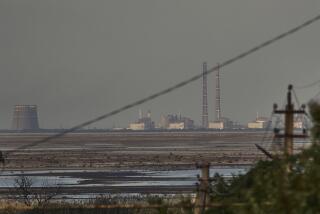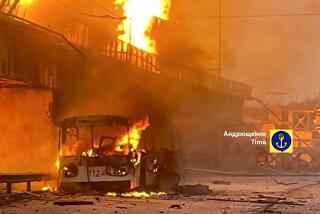Radiation Falls, Reactor Cooler, Soviets Declare
- Share via
MOSCOW — The Soviet government said Saturday that radiation emissions from the Chernobyl nuclear disaster site have fallen sharply and that the core of the damaged reactor is cooling down substantially.
The level of radioactivity in Kiev, 60 miles south of the power plant, has dropped to 0.32 milliroentgens per hour and is “absolutely safe,” a government statement said.
A report in the West German magazine Der Spiegel said that the death toll from the worst nuclear accident in history has climbed to four.
Causes of Deaths
The magazine quoted Valentin M. Falin, head of the Novosti press agency, as saying that two men were killed in the explosion and ensuing fire at the plant, while two more have since died from radiation exposure. Falin was not available for comment on the report.
The Council of Ministers, which first announced that two people were killed in the accident, did not mention any additional deaths in Saturday’s report to the public.
Soviet officials have said that 204 people were flown from Chernobyl to Moscow hospitals and 18 of them, suffering from fourth-degree radiation, were in serious condition.
Hans Blix, director general of the International Atomic Energy Agency, said that before the Chernobyl accident, no one had ever died from the effects of radiation in a civilian nuclear power plant accident.
In an interview with Der Spiegel, Falin, a former Soviet ambassador to Bonn, was quoted as admitting that the Kremlin was slow to inform the world of the time and the extent of the disaster that erupted shortly after 1 a.m. Saturday, April 26.
Disclosure Delay
“Viewed in retrospect, it appears to me that it would have been better if the information we released on Monday (April 28) had already been released on Sunday,” he said, in another of a series of admissions Soviet officials have made outside their own country.
But he was also quoted as saying, “In order to see the situation objectively, we have to take into account the fact that initial reports from the leadership at the Chernobyl nuclear plant were incomplete and later proved incorrect.”
“In critical situations there are various ways to react,” Falin added. “This time the best way was not chosen.”
In a report Saturday, the Council of Ministers said that temperatures inside the reactor went down substantially as a result of countermeasures by Soviet engineers
“The opinion of scientists and specialists is that this is indicative of a practical termination of the reactor’s graphite burning process,” the statement said.
“The release of radioactive substances has sharply diminished,” it added.
Radiation Readings Provided
In compliance with an agreement made with the IAEA, a Vienna-based agency of the United Nations, the Soviets provided radiation readings from seven observation posts to the agency for wide circulation.
A station about 40 miles from Chernobyl showed a reading of 0.33 milliroentgens per hour, the statement noted, while the radiation level on the Western border of the Soviet Union was within “normal background levels.”
A milliroentgen is one-thousandth of a roentgen, the standard measure of ionizing radiation. Experts say exposure to 50 roentgens or more per year is dangerous and 400 roentgens per year can be fatal.
Work to decontaminate the power station, highways in the area and nearby buildings has started on a large scale, the government reported.
Meantime, Leonid A. Ilyin, vice president of the Academy of Medical Sciences, said in an interview on the main evening television news show that radiation levels in Kiev are far too low to cause harm and are dropping still further.
Precautions Ordered
Kiev, the Ukrainian capital with a population of 2.4 million, has directed residents to wash floors daily, to keep children indoors except for an hour each day and to scrub leafy vegetables.
Schools in Kiev for Grades 1-7 were closed for vacation 10 days early to allow 250,000 youngsters to leave the city. Thousands of children and their parents already had left the city despite official reassurances that Chernobyl radiation posed no danger to health.
Charles Bremner, a Reuters news agency correspondent who went to Kiev with the first group of foreign reporters allowed into the city since the accident, said there is no panic but considerable concern in that city about Chernobyl.
“We don’t know about the long-term effects,” Bremner quoted a science teacher as saying. “People are worried.” But many other people did not question the use of nuclear power or the government’s handling of the event, he added.
A teen-age girl named Antonia, evacuated from a village in the 19-mile danger zone around Chernobyl, told a reporter: “We have thought about long-term effects, but what can we do about it?”
Upbeat Reporting
After an initial period of virtual silence, the state-run media have struck an upbeat note in reporting on the accident. Neither television nor newspaper reports have indicated that Chernobyl was by far the worst disaster in the history of nuclear energy generation or mentioned such long-term effects of radiation as cancer.
But Soviet media have been full of attacks on Western reporting of the accident, charging that it was distorted in an effort to discredit the Soviet Union.
Meantime, the first hero of Chernobyl was celebrated in the pages of Izvestia, the official government newspaper. It said that Leonid Telyatnikov, 35, led a team of firefighters who braved radiation and acrid smoke to stop the flames pouring from the damaged reactor from spreading to other reactors nearby.
Telyatnikov, hospitalized in Moscow Clinic No. 6, remained at the site for three hours after the explosion and fire broke out two weeks ago, the newspaper said.
“I am OK,” Telyatnikov was quoted as saying. His doctor said: “We are hoping for the best.”
More to Read
Sign up for Essential California
The most important California stories and recommendations in your inbox every morning.
You may occasionally receive promotional content from the Los Angeles Times.













